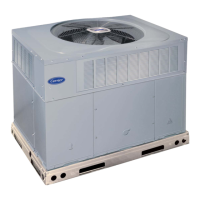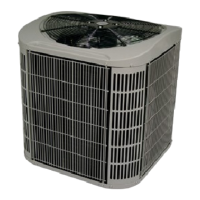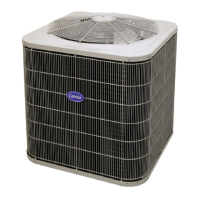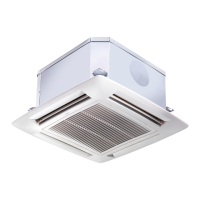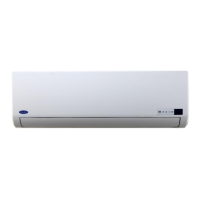315S: Installation Instructions
Manufacturer reserves the right to change, at any time, specifications and designs without notice and without obligations.
8
Final Wiring Check
IMPORTANT: Check factory wiring and field wire connections to
ensure terminations are secured properly. Check wire routing to ensure
wires are not in contact with tubing, sheet metal, etc.
Compressor Crankcase Heater
When equipped with a crankcase heater, furnish power to heater a
minimum of 24 hr before starting unit. To furnish power to heater only,
set thermostat to OFF and close electrical disconnect to outdoor unit.
A crankcase heater is required if refrigerant tubing is longer than 80 ft.
(24 m) or when outdoor unit is 35 ft. (6 m) below indoor unit. Refer to
the Residential Piping and Longline Guideline and Service Manual.
Install Electrical Accessories
Refer to the individual instructions packaged with kits or accessories
when installing.
Start-Up
Follow these steps to properly start up system:
1. After system is evacuated, fully open liquid and vapor service
valves.
2. Unit is shipped with valve stem(s) front seated (closed) and caps
installed. Replace stem caps after system is opened to refrigerant
flow. Replace caps finger-tight and tighten with wrench an
additional 1/12 turn.
3. Close electrical disconnects to energize system.
4. Set room thermostat at desired temperature. Be sure set point is
below indoor ambient temperature.
5. Set room thermostat to COOL and fan control to ON or AUTO
mode, as desired. Operate unit for 15 minutes. Check system
refrigerant charge.
Sequence of Operation
Turn on power to indoor and outdoor units. Transformer is energized.
On a call for cooling, thermostat makes circuits R-Y and R-G. Circuit
R-Y energizes contactor, starting outdoor fan motor and compressor
circuit. R-G energizes indoor unit blower relay, starting indoor blower
motor on high speed.
When thermostat is satisfied, its contacts open, de-energizing contactor
and blower relay. Compressor and motors should stop.
If indoor unit is equipped with a time-delay relay circuit, the indoor
blower will run up to 90 seconds to increase system efficiency.
Check Charge
Factory charge amount and desired subcooling are shown on unit rating
plate. Charging method is shown on information plate inside unit.
For TXV, use subcooling method. For piston, use superheat method.To
properly check or adjust charge, conditions must be favorable for
subcooling charging. Favorable conditions exist when the outdoor
temperature is between 70°F and 100°F (21°C and 38°C), and the indoor
temperature is between 70°F and 80°F (21°C and 27°C). Follow the
procedure below:
Unit is factory charged for 15ft (4.57 m) of lineset. Adjust charge by
adding or removing 0.6 oz/ft of 3/8 liquid line above or below 15 ft. (4.6
m) respectively.
Allow system to operate at least 15 minutes. If conditions are favorable,
check system charge by super heat method for fixed metering device and
subcooling method for TXV. If any adjustment is necessary, adjust
charge slowly and allow system to operate for 15 minutes to stabilize
before declaring a properly charged system.
If the indoor temperature is above 80°F (27°C), and the outdoor
temperature is in the favorable range, adjust system charge by weight
based on line length and allow the indoor temperature to drop to 80°F
(27°C) before attempting to check system charge by subcooling method
as described above.
If the indoor temperature is below 70°F (21°C), or the outdoor
temperature is not in the favorable range, adjust charge for line set length
above or below 15 ft. (4.6 m) only. Charge level should then be
appropriate for the system to achieve rated capacity. The charge level
could then be checked at another time when the both indoor and outdoor
temperatures are in a more favorable range.
NOTE: If line length is beyond 80 ft (24 m) or greater than 35 ft (11 m)
vertical separation, See Residential Piping and Long Line Guideline for
special charging requirements.
CAUTION
!
UNIT OPERATION AND SAFETY HAZARD
Failure to follow this caution may result in personal injury, equipment
damage or improper operation.
• Do not overcharge system with refrigerant.
• Do not operate unit in a vacuum or at negative pressure.
• Compressor dome temperatures may be hot.
CAUTION
!
PERSONAL INJURY HAZARD
Failure to follow this caution may result in personal injury.
Wear safety glasses, protective clothing, and gloves when handling
refrigerant and observe the following:
• Front seating service valves are equipped with Schrader valves.

